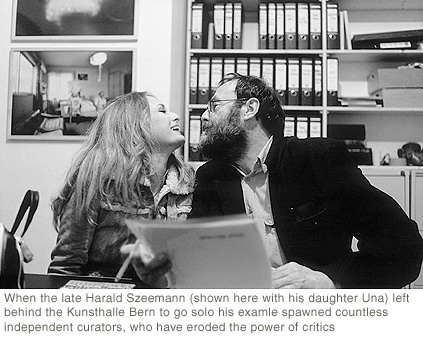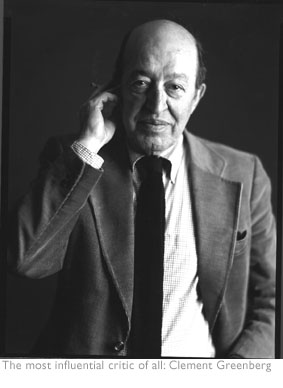|
Do Art Critics Still Matter?
Today’s frenetic art world pushes criticism
to the sidelines—and many critics are not helping matters
By Marc Spiegler
In the popular imagination, the
art critic seems a commanding figure, making and breaking
careers at will, but one hard look at today’s contemporary
art system reveals this notion to be delusional.“When I entered
the art world, famous critics had an aura of power”, recalls
ArtBasel director Samuel Keller. “Now they’re more like philosophers—respected,
but not as powerful as collectors, dealers or curators. Nobody
fears critics any more, which is a real danger sign for the
profession.”
 At
one fundamental level—money—critics are scarcely valued either.
Even the swankiest art publications, such as Art Forum, Frieze
and Art in America pay only $100 to $150 per freelance review.
“I’ve never made a really viable living while working in art
publishing and writing art criticism in New York for the past
decade, which makes me feel rather powerless”, says critic
Sarah Valdez, whose writing appears regularly in Art in America
and Paper magazine. “I know that galleries and artists might
benefit financially if I review a show positively. But to
consider this ‘a position of power’ would be for me—or any
critic—completely ludicrous.” Not surprisingly, arts criticism
today tends to be a stepping-stone toward more stable and
remunerative employment, such as academia (Daniel Birnbaum
of the Städelschule Frankfurt), art consulting (Allan Schwartzman,
for clients such as Brazilian tycoon Bernardo Paz) or art
dealing (Christian Viveros- Fauné of New York’s Roebling Hall
galleries). At
one fundamental level—money—critics are scarcely valued either.
Even the swankiest art publications, such as Art Forum, Frieze
and Art in America pay only $100 to $150 per freelance review.
“I’ve never made a really viable living while working in art
publishing and writing art criticism in New York for the past
decade, which makes me feel rather powerless”, says critic
Sarah Valdez, whose writing appears regularly in Art in America
and Paper magazine. “I know that galleries and artists might
benefit financially if I review a show positively. But to
consider this ‘a position of power’ would be for me—or any
critic—completely ludicrous.” Not surprisingly, arts criticism
today tends to be a stepping-stone toward more stable and
remunerative employment, such as academia (Daniel Birnbaum
of the Städelschule Frankfurt), art consulting (Allan Schwartzman,
for clients such as Brazilian tycoon Bernardo Paz) or art
dealing (Christian Viveros- Fauné of New York’s Roebling Hall
galleries).
Only a fool goes into the arts
for the money, of course; prestige is the bigger draw. For
centuries, criticism functioned as the rough draft of art
history, drubbing out bad work while championing the innovative
and accomplished. Yet today we have no Clement Greenberg laying
down the law on Modernism or Pierre Restany defining New Realism.
“By the time I began writing about art in New York—during
the 1980s East Village scene—it seemed as though the critics
wielded a different kind of influence than those of previous
generations”, recalls Calvin Reid, an artist and critic for
publications including Art in America and Artnet. “Critical
influence was a version of enlightened public relations, as
critics became more informational, less purely analytic and
less imperial in their impact on an artist’s perceived value
and level of public attention. And dealers certainly became
more important, aggressively pushing their actual and perceived
power to put an artist in the limelight.”
Granted, today’s critics still
have the power of directing their spotlight. “I can’t tell
you how often I go into a museum or gallery and have someone
practically beg for coverage”, points out Tyler Green, the
Bloomberg News art critic better known for his blog Modern
Art Notes. “There are so many galleries and museums, and such
a limited number of media outlets, that they all fight for
whatever reviews they can get.”
But curators usually beat critics
to the punch when it comes to “making” artists. Long before
reviewers started weighing in on P.S.1’s “Greater New York”
show, which opened in March, there was a half-year hype during
which galleries and collectors swarmed the studios of the
artists selected for inclusion. In that sense, on the day
in 1969 that Harald Szeemann went freelance by leaving the
Kunsthalle Bern, the wind turned against criticism. Other
curators soon followed his lead, working unfettered by a single
institution’s constraints. “The role of the critic has been
gradually taken over by the curator”, notes Stockholm’s Power
Ekroth, who writes criticism for artforum.com, edits Site
magazine, and also curates exhibitions. “The curator builds
up a career by becoming the new stronghold for validation
of taste. The curator is also closer to the artist, because
where the critic is trying to be ‘objective’ the curator is
clearly subjective.” 
Even collectors have jumped into
this fray, canvassing the globe for discoveries. Thus, by
the time many foreign artists hit the New York/London axis,
their markets are already burgeoning and their exhibition
schedules set; the reviewers come too late to the party. “Personally
I don’t feel I have any power at all”, says Italian critic
Michele Robecchi, senior editor of London’s Contemporary magazine.
“There are critics who think they do, but even a major magazine
feature is unlikely to change your life or that of the artist,
bigpicture wise. As far as I’m concerned, the only people
in a position of power are the great artists.” Tellingly,
Madrid’s ARCO, which boasts the most ambitious discussion
programme of any art fair, held only one panel on arts criticism
this February, compared to six on collecting art and five
on curating. (Full disclosure: I was on that criticism panel,
despite being only an occasional critic.)
Ultimately, the critic seems
trapped in an inherently reactive and ever-more marginalised
position. After all, the function of critics has remained
largely static while the art world metastasised, growing too
big to allow them any real overview, charging too fast for
their publication deadlines and developing a slew of new information
channels that bypass critics altogether. Not so long ago,
Europeans depended upon travelling critics to relate the latest
developments in New York or London. Today, fairs and biennials
function as seasonal trend updates, and anyone curious about
a faraway show can simply hit the gallery’s website for JPGs
and a press release.
Of course, that’s not the same
as reading a thorough review. Which brings us to another problem
for critics: scanning is rapidly replacing reading. One major
New York dealer recalls surreal results after the first show
by the gallery’s new star was pole-axed by The New York Times.
“For two weeks people called up to congratulate me on the
‘great review’ ”, the dealer recalls, requesting anonymity
(clearly, critics retain some power). “They only registered
the review’s existence, not the reviewer’s opinion.” Based
on personal experience, Ms Valdez sees things similarly. “The
problem is not that critics are disempowered so much as the
fact that people are generally intellectually lazy”, she states.
“That said, even I have to admit it’s hard to stay awake reading
most art reviews.”
Indeed, while external factors
undermine the impact of critics, their often impenetrable
writing hardly helps matters. British author Simon Winchester,
a man sufficiently literate to have traced the Oxford English
Dictionary’s origins, once set himself the task of parsing
esteemed critic Benjamin Buchloh’s texts. After two years,
he abandoned the mission, confessing that Buchloh “remains
as obscure and unyielding for me as Assyrian or the grass
script of the early Chinese”. An extreme example, perhaps.
Yet it hardly seems coincidence that the English-language
critics commonly cited as being influential—Jerry Saltz of
the Village Voice, Roberta Smith and Michael Kimmelman at
the New York Times, Adrian Searle and Jonathan Jones of The
Guardian and Richard Dorment of The Daily Telegraph—all work
for mass-market newspapers, forcing them to weave even their
most complex ideas into a prose stripped bare of indigestible
artspeak.
Just as importantly, to have
an impact critics need to criticise, and far too much
of today’s art writing, especially in art magazines, is merely
descriptive or context-giving. Sometimes this stems from a
theoretical notion that “judging” work is passé, but many
observers suspect more practical considerations are at play.
“I don’t think of the art-magazine critics as critics, really”,
says one veteran London gallerist. “They’re part of the scene
and always seem to be thinking more about their other options
in the art world.”
Professional entanglements run
rife between critics and the galleries whose works they review.
Few critics have staff positions in galleries, but many do
short-term business with them, either for curatorial gigs
or while writing catalogue essays. In a classic 2002 Village
Voice column, “Learning on the Job,” Saltz derided that practice:
“The writer acts as a paid gun or apologist, not a critic;
what he or she writes must be approved to be published. Perhaps
critics’ fees should be printed along with their essays, as
artists’ prices are available on gallery checklists.”
Yes, there is a difference between
impropriety and the appearance of impropriety. I raised the
catalogueessay issue during the ARCO panel, and Adrian Searle
told me to “Grow up”, remonstrating that he had curated shows
and contributed to catalogues without compromising his independence—an
assessment his loyal fans (including me) would accept. That
said, no reputable magazine would employ a film critic pitching
Hollywood scripts, a music critic doing A&R work, or an author
reviewing books by other members of his publisher’s stable.
How weird has critical ethics grown? In a 2002 survey conducted
by the National Arts Journalism Program at Columbia University,
only 20% of American critics polled felt it was never acceptable
to write about artists whose works they owned or collect.
The art world, like any organism,
requires a certain amount of pruning to stay healthy. So the
disempowerment of critics—our putative pruners—should cause
concern. What is to be done for them to remain relevant? Paying
a living wage would help. Failing that unlikely development,
conflicts of interest should be signalled to the readers.
(And perhaps when the full-disclosure notice starts getting
embarrassingly long, everyone involved will think better of
an assignment). Obviously, an unremitting emphasis on clear,
compelling writing would give critics some chance of actually
being read.
But in a system with so many
intertwined players, the one power critics can really exploit
is that of rendering independent judgment. Flinching critics
do no one in the art world any favours; when almost every
review is positive, then no review means much. As for fears
of bruising fragile egos and thereby imperiling art’s progress,
consider the words of William Kentridge: “No critic’s review
of an exhibition has ever been harsher than what that artist
has dreamt up at 3a.m. on his own.”
|

